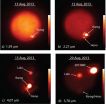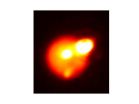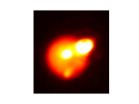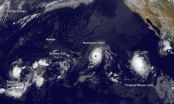(Press-News.org) Three massive volcanic eruptions occurred on Jupiter's moon Io within a two-week period last August, leading astronomers to speculate that these presumed rare "outbursts," which can send material hundreds of miles above the surface, might be much more common than astronomers thought.
"We typically expect one huge outburst every one or two years, and they're usually not this bright," said Imke de Pater, professor and chair of astronomy at the University of California, Berkeley, and lead author of one of two papers describing the eruptions. "Here we had three extremely bright outbursts, which suggest that if we looked more frequently we might see many more of them on Io."
Io, the innermost of Jupiter's four large "Galilean" moons, is about 2,300 miles across, about the size of Earth's moon. Aside from Earth, is the only known place in the solar system with volcanoes erupting extremely hot lava like that seen on Earth. Because of Io's low gravity, large volcanic eruptions produce an umbrella of debris that rises high into space.
De Pater's long-time colleague and coauthor Ashley Davies, a volcanologist with NASA's Jet Propulsion Laboratory at the California Institute of Technology in Pasadena, Calif., said that the recent eruptions match past events that spewed tens of cubic miles of lava over hundreds of square miles in a short period of time.
"These new events are in a relatively rare class of eruptions on Io because of their size and astonishingly high thermal emission," he said. "The amount of energy being emitted by these eruptions implies lava fountains gushing out of fissures at a very large volume per second, forming lava flows that quickly spread over the surface of Io."
All three events, including the largest, most powerful eruption of the trio on 29 Aug. 2013, were likely characterized by "curtains of fire", as lava blasted out of fissures perhaps several miles long.
The papers, one with lead author Katherine de Kleer, a UC Berkeley graduate student, and coauthored by UC Berkeley research astronomer Máté Ádámkovics, and the other coauthored by Ádámkovics and David R. Ciardi of Caltech's NASA Exoplanet Science Institute, have been accepted for publication in the journal Icarus.
Lava fountains on Io
De Pater discovered the first two massive eruptions on Aug. 15, 2013, using the near-infrared camera (NIRC2) coupled to the adaptive optics system on the Keck II telescope, one of two 10-meter telescopes operated by the W. M. Keck Observatory in Hawaii. The brightest, at a caldera named Rarog Patera, was calculated to have produced a 50 square-mile, 30-foot thick lava flow, while the other, close to another caldera called Heno Patera, produced flows covering 120 square miles. Both were located in Io's southern hemisphere, near its limb, and were nearly gone when imaged five days later.
De Pater discovered a third and even brighter eruption – one of the brightest ever seen on Io – on Aug. 29 at the start of a year-long series of Io observations led by de Kleer, using both the Near-Infrared Imager with adaptive optics on the Gemini North telescope on Mauna Kea, and the SpeX near-infrared spectrometer on NASA's nearby Infrared Telescope Facility (IRTF). De Kleer used the fortuitous detection of this outburst simultaneously at Gemini and the IRTF to show that the eruption temperature is likely much higher than typical eruption temperatures on Earth today, "indicative of a composition of the magma that on Earth only occurred in our planet's formative years," de Kleer said.
At the time of the observation, the thermal source had an area of up to 32 square miles. The modelled temperature of the lava indicated it had barely had time to cool, suggesting that the event was dominated by lava fountains.
"We are looking at several cubic miles of lava in rapidly emplaced flows," said Davies, who has developed models to predict the volume of magma erupted based on spectroscopic observations. "This will help us understand the processes that helped shape the surfaces of all the terrestrial planets, including Earth, and the moon."
The team tracked the heat of the third outburst for almost two weeks after its discovery to investigate how volcanoes influence Io's atmosphere and how these eruptions feed a doughnut of ionized gas - the Io plasma torus - that surrounds Jupiter near Io's orbit. De Kleer timed her Gemini and IRTF observations to coincide with observations of the plasma torus by the Japanese HISAKI (SPRINT-A) spacecraft, which is in orbit around Earth, so she can correlate the different data sets.
A volcanic laboratory
Volcanoes were first noted on Io in 1979, and subsequent studies by the Galileo spacecraft, which first flew by Io in 1996, and ground-based telescopes show that eruptions and lava fountains occur constantly, creating rivers and lakes of lava. But large eruptions, creating vast lava flows in some cases thousands of square miles in area, were thought to be rare. Only 13 were observed between 1978 and 2006, in part because only a handful of astronomers, de Pater among them, regularly scan the moon.
Davies' interest in Io's volcanoes arises from the moon's resemblance to an early Earth when heat from the decay of radioactive elements – much more intense than radiogenic heating today – created exotic, high-temperature lavas. Io remains volcanically active for a different reason – Jupiter and the moons Europa and Ganymede constantly tug on it – but the current eruptions on Io are likely similar to those that shaped the surfaces of inner solar system planets such as Earth and Venus in their youth.
"We are using Io as a volcanic laboratory, where we can look back into the past of the terrestrial planets to get a better understanding of how these large eruptions took place, and how fast and how long they lasted," Davies said.
In a third paper accepted by Icarus, de Pater, Davies and their colleagues summarize a decade of Io observations with the Keck II and Gemini telescopes. Their map of the surface of Io pinpointed more than two dozen hot spots whose spatial distribution changed significantly between 2001 and 2010. In 2010 the hot spots were dominated by two volcanic centers: Loki Patera, an extremely large active lava lake on Io, and Kanehekili Fluctus, an area of continuing pahoehoe lava flows.
The team hopes that monitoring Io's surface annually will reveal the style of volcanic eruptions on the moon, constrain the composition of the magma, and accurately map the spatial distribution of the heat flow and potential variations over time. This information is essential to get a better understanding of the physical processes involved in the heating and cooling processes on Io, de Pater said.
INFORMATION:
The work is funded by the National Science Foundation and NASA's Outer Planets Research and Planetary Geology and Geophysics Programs.
A hellacious two weeks on Jupiter's moon Io
Keck, Gemini telescopes catch three of the largest volcanic eruptions ever on Io
2014-08-04
ELSE PRESS RELEASES FROM THIS DATE:
Single-fraction RT as effective as multiple-fraction RT for palliation of bone metastases
2014-08-04
Fairfax, Va., August 4, 2014—Standardizing prescribing practices for single-fraction radiation therapy (SFRT) for palliation of bone metastases could lead to cost savings and improvement in patients' quality of life, according to a study published in the August 1, 2014 edition of the International Journal of Radiation Oncology • Biology • Physics (Red Journal), the official scientific journal of the American Society for Radiation Oncology (ASTRO).
Bone metastases are a common manifestation of distant spread of disease, occurring most frequently with prostate, breast ...
How long does it take to make a natural fracture?
2014-08-04
Boulder, Colo., USA – How long does it take for natural Earth processes to form hydraulic fractures? Is the formation driven by sediment compaction, oil and gas generation, or something else? What role do these natural fractures play in modern hydraulic fracturing production? A new GSA BULLETIN study by András Fall and colleagues from The University of Texas at Austin, Virginia Tech, and ExxonMobil addresses these questions, and the article is open-access online.
The process of fracture formation by a natural increase in pore-fluid pressure has previously been referred ...
Bottling up sound waves
2014-08-04
There's a new wave of sound on the horizon carrying with it a broad scope of tantalizing potential applications, including advanced ultrasonic imaging and therapy, acoustic cloaking, and levitation and particle manipulation. Researchers with the U.S. Department of Energy (DOE)'s Lawrence Berkeley National Laboratory (Berkeley Lab) have developed a technique for generating acoustic bottles in open air that can bend the paths of sound waves along prescribed convex trajectories.
Sound waves move much like light waves. They travel on a straight path but this path - through ...
Extreme volcanism: Image captures 1 of the brightest volcanoes in the solar system
2014-08-04
During the middle of 2013, Jupiter's moon Io came alive with volcanism. Now, an image from the Gemini Observatory captures what is one of the brightest volcanoes ever seen in our solar system. The image, obtained on August 29, reveals the magnitude of the eruption that was the "grand finale" in a series of eruptions on the distant moon. Io's volcanism is caused by the tidal push-and-pull of massive Jupiter, which heats the satellite's interior – making it our Solar System's most volcanically active known body.
According to University of California Berkeley (UCB) astronomer ...
Earlier intervention for common form of heart attack linked to improved survival
2014-08-04
Changes in the treatment of the most common form of heart attack over the past decade have been associated with higher survival rates for men and women regardless of age, race and ethnicity, according to a UCLA-led analysis.
But the study also suggests that there is room for improvement in how current treatment guidelines are applied among specific patient groups.
The researchers reviewed records for 6.5 million people who were treated for heart attacks between 2002 and 2011. The analysis was among the first and largest national studies to assess the impact of the trend ...
Anorexia fueled by pride about weight loss
2014-08-04
Positive emotions – even those viewed through a distorted lens – may play an exacerbating role in fueling eating disorders like anorexia nervosa, which has a death rate 12 times higher for females between the ages of 15 and 24 than all other causes of death combined, according to a Rutgers study.
In research published in Clinical Psychological Science, Edward Selby, an assistant professor in the Department of Psychology, School of Arts and Sciences, measured over a two week period the emotional states of 118 women between the ages of 18-58 being treated for anorexia nervosa. ...
Satellite view of a hyperactive Eastern and Central Pacific Ocean
2014-08-04
NASA and NOAA satellites have been supplying forecasters with data developing tropical cyclones in the Eastern and Central Pacific Ocean and over the last several days. There have been as many as five tropical systems at the same time. On Monday, August 4, there were three tropical systems stretching from west to east: Tropical Depression Genevieve in the Central Pacific, Hurricane Iselle and Tropical Storm Julio in the Eastern Pacific.
Tropical Depression Genevieve May Strengthen
On August 4, Tropical Depression Genevieve was located about 930 miles (1,495 km) southwest ...
Version 2.0 of Prostate Cancer Risk Calculator now online, complete with emojis
2014-08-04
SAN ANTONIO (August 4, 2014) — A calculator to help men and their doctors assess their risk of prostate cancer, developed at the UT Health Science Center, has had a major upgrade to enhance how men and their physicians better understand a man's risk of prostate cancer.
A description of the update's needs and benefits is described by the Health Science Center authors in a viewpoint published online Monday in the Journal of the American Medical Association.
"The prostate cancer risk calculator has been updated using current risk factors and a better interface; the current ...
Newly discovered juvenile whale shark aggregation in Red Sea
2014-08-04
Whale sharks (Rhincodon typus)—which grow more than 30 feet long—are the largest fish in the world's ocean, but little is known about their movements on a daily basis or over years. A newly discovered juvenile whale shark aggregation off Saudi Arabia is giving researchers a rare glimpse into the lives of these gentle giants.
Scientists from the Woods Hole Oceanographic Institution (WHOI) and colleagues from the King Abdullah University of Science and Technology (KAUST) and Massachusetts Division of Marine Fisheries report on the movements of whale sharks tagged at the ...
Horses communicate with their eyes and mobile ears
2014-08-04
Horses are sensitive to the facial expressions and attention of other horses, including the direction of the eyes and ears. The findings, reported in the Cell Press journal Current Biology on August 4, are a reminder for us humans to look beyond our own limitations and recognize that other species may communicate in ways that we can't, the researchers say. After all, human ears aren't mobile.
"Our study is the first to examine a potential cue to attention that humans do not have: the ears," says Jennifer Wathan of the University of Sussex. "Previous work investigating ...
LAST 30 PRESS RELEASES:
Azacitidine–venetoclax combination outperforms standard care in acute myeloid leukemia patients eligible for intensive chemotherapy
Adding epcoritamab to standard second-line therapy improves follicular lymphoma outcomes
New findings support a chemo-free approach for treating Ph+ ALL
Non-covalent btki pirtobrutinib shows promise as frontline therapy for CLL/SLL
University of Cincinnati experts present research at annual hematology event
ASH 2025: Antibody therapy eradicates traces of multiple myeloma in preliminary trial
ASH 2025: AI uncovers how DNA architecture failures trigger blood cancer
ASH 2025: New study shows that patients can safely receive stem cell transplants from mismatched, unrelated donors
Protective regimen allows successful stem cell transplant even without close genetic match between donor and recipient
Continuous and fixed-duration treatments result in similar outcomes for CLL
Measurable residual disease shows strong potential as an early indicator of survival in patients with acute myeloid leukemia
Chemotherapy and radiation are comparable as pre-transplant conditioning for patients with b-acute lymphoblastic leukemia who have no measurable residual disease
Roughly one-third of families with children being treated for leukemia struggle to pay living expenses
Quality improvement project results in increased screening and treatment for iron deficiency in pregnancy
IV iron improves survival, increases hemoglobin in hospitalized patients with iron-deficiency anemia and an acute infection
Black patients with acute myeloid leukemia are younger at diagnosis and experience poorer survival outcomes than White patients
Emergency departments fall short on delivering timely treatment for sickle cell pain
Study shows no clear evidence of harm from hydroxyurea use during pregnancy
Long-term outlook is positive for most after hematopoietic cell transplant for sickle cell disease
Study offers real-world data on commercial implementation of gene therapies for sickle cell disease and beta thalassemia
Early results suggest exa-cel gene therapy works well in children
NTIDE: Disability employment holds steady after data hiatus
Social lives of viruses affect antiviral resistance
Dose of psilocybin, dash of rabies point to treatment for depression
Helping health care providers navigate social, political, and legal barriers to patient care
Barrow Neurological Institute, University of Calgary study urges “major change” to migraine treatment in Emergency Departments
Using smartphones to improve disaster search and rescue
Robust new photocatalyst paves the way for cleaner hydrogen peroxide production and greener chemical manufacturing
Ultrafast material captures toxic PFAS at record speed and capacity
Plant phenolic acids supercharge old antibiotics against multidrug resistant E. coli
[Press-News.org] A hellacious two weeks on Jupiter's moon IoKeck, Gemini telescopes catch three of the largest volcanic eruptions ever on Io







